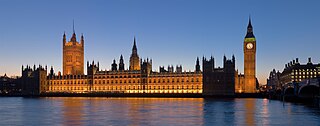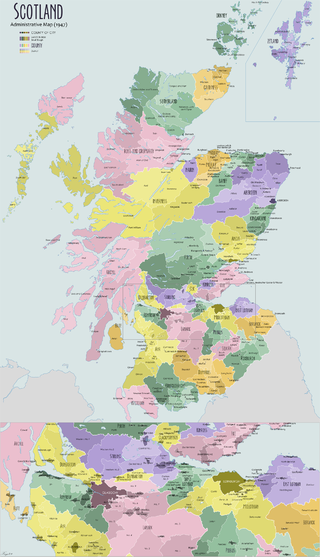
The Acts of Union were two Acts of Parliament: the Union with Scotland Act 1706 passed by the Parliament of England, and the Union with England Act 1707 passed by the Parliament of Scotland. They put into effect the terms of the Treaty of Union that had been agreed on 22 July 1706, following negotiation between commissioners representing the parliaments of the two countries. By the two Acts, the Kingdom of England and the Kingdom of Scotland—which at the time were separate states with separate legislatures, but with the same monarch—were, in the words of the Treaty, "United into One Kingdom by the Name of Great Britain".

In modern politics, and history, a parliament is a legislative body of government. Generally, a modern parliament has three functions: representing the electorate, making laws, and overseeing the government via hearings and inquiries. The term is similar to the idea of a senate, synod or congress and is commonly used in countries that are current or former monarchies. Some contexts restrict the use of the word parliament to parliamentary systems, although it is also used to describe the legislature in some presidential systems, even where it is not in the official name.

A legislature is an assembly with the authority to make laws for a political entity such as a country or city. They are often contrasted with the executive and judicial powers of government.

A royal burgh was a type of Scottish burgh which had been founded by, or subsequently granted, a royal charter. Although abolished by law in 1975, the term is still used by many former royal burghs.

The shires of Scotland, or counties of Scotland, are historic subdivisions of Scotland established in the Middle Ages and used as administrative divisions until 1975. Originally established for judicial purposes, from the 17th century they started to be used for local administration purposes as well. The areas used for judicial functions (sheriffdoms) came to diverge from the shires, which ceased to be used for local government purposes after 1975 under the Local Government (Scotland) Act 1973.

The estates of the realm, or three estates, were the broad orders of social hierarchy used in Christendom from the Middle Ages to early modern Europe. Different systems for dividing society members into estates developed and evolved over time.

The Parliament of Scotland was the legislature of the Kingdom of Scotland from the 13th century until 1707. The parliament evolved during the early 13th century from the king's council of bishops and earls, with the first identifiable parliament being held in 1235 during the reign of Alexander II, when it already possessed a political and judicial role.
The Act of Union 1707 and pre-Union Scottish legislation provided for 14 Members of Parliament (MPs) from Scotland to be elected from districts of burghs. All the parliamentary burghs were assigned to a district, except for Edinburgh which had an MP to itself. The burghs in a district were not necessarily adjacent or even close together.
Tain Burghs, was a constituency of the House of Commons of the Parliament of Great Britain from 1708 to 1801 and of the Parliament of the United Kingdom from 1801 to 1832, sometimes known as Northern Burghs. It was represented by one Member of Parliament (MP).

The History of local government in Scotland is a complex tale of largely ancient and long established Scottish political units being replaced after the mid 20th century by a frequently changing series of different local government arrangements.
Commissioners of Supply were local administrative bodies in Scotland from 1667 to 1930. Originally established in each sheriffdom to collect tax, they later took on much of the responsibility for the local government of the counties of Scotland. In 1890 they ceded most of their duties to the county councils created by the Local Government (Scotland) Act 1889. They were finally abolished in 1930.
The Convention of Royal Burghs, more fully termed the Convention of the Royal Burghs of Scotland, was a representative assembly which protected the privileges and pursued the interests of Scotland’s principal trading towns, the royal burghs, from the middle of the 16th century to the second half of the 20th century. It evolved as a forum in which burgh delegates, termed "commissioners", could "consult together and take common action in matters concerning their common welfare" before and during the sittings of parliament. An exclusively merchant body, it was essentially a parliament which "declared the law of the burghs" just as the Scottish Parliament "declared the law of the land". The Convention expanded over time by admitting lesser burghs to its membership; and by the 16th century had grown in influence to the extent that "it was listened to rather than directed by the government". Though still known as the "convention of royal burghs", it referred to itself from the late 17th century onwards as simply the "convention of burghs", as by then membership was no longer restricted exclusively to royal burghs and commissioners from all types of burgh were represented in parliament.
Kintore in Aberdeenshire was a royal burgh that returned one commissioner to the Parliament of Scotland and to the Convention of Estates.
Nairn was a burgh constituency that elected one commissioner to the Parliament of Scotland and to the Convention of Estates.
Forfar was a royal burgh that returned one commissioner to the Parliament of Scotland and to the Convention of Estates.
Before the Act of Union 1707, the barons of the shire of Cromarty elected commissioners to represent them in the unicameral Parliament of Scotland and in the Convention of Estates. After 1708, Cromartyshire and Nairnshire alternated in returning one member to the House of Commons of Great Britain and later to the House of Commons of the United Kingdom.
Before the Acts of Union 1707, the barons of the shire of Fife elected commissioners to represent them in the Parliament of Scotland and in the Convention of the Estates. The number of commissioners was increased from two to four in 1690.
St Andrews in Fife was a royal burgh that returned one commissioner to the Parliament of Scotland and to the Convention of Estates.
Renfrew was a royal burgh that returned one commissioner to the Parliament of Scotland and to the Convention of Estates.










